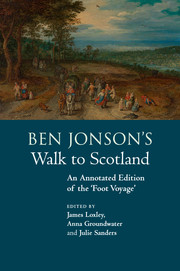Introduction: Jonson’s ‘Foot Voyage’ and the Aldersey manuscript
Published online by Cambridge University Press: 05 December 2014
Summary
A discovery
Ben Jonson’s walk from London to Edinburgh has caught the imagination and provoked the curiosity of many since it was first mooted in June 1617, a year before he set off. The journey itself was not the adventure it might have been before the Union of the Crowns, but that a celebrated and, frankly, weighty poet should choose to attempt it on foot was certainly remarkable. Most importantly, the expedition produced the encounter between Jonson and William Drummond recalled in the latter’s notes of his guest’s conversation and opinions, or ‘informations’. The views, jests and anecdotes set down there illuminate Jonson’s poetic principles, his views of his contemporaries, and the account he chose to give of himself. They are particularly beguiling for allowing us to imagine that we are hearing Jonson speak off the record, as it were, and that we can catch his conversational tone even through Drummond’s editorial compressions and sometimes pursed lips. The Informations also provide us with glimpses of the journey itself, including Jonson’s irritation at being followed – mocked, he thought – by Taylor, and his purchase of a pair of shoes at Darlington, which he ‘minded to take back that far again’ (ll.514–15). Such snippets have been combined with a sparse patchwork of other sources to build up an outline picture of Jonson’s walk and his possible motives for undertaking it. We also know from Edinburgh records that Jonson was made a burgess of the city, and that a dinner was held there in his honour in September 1618. In his Pennyles Pilgrimage Taylor records meeting his fellow poet at the house of John Stewart in Leith, while Jonson’s correspondence with Drummond and a dedication inscribed in a book presented to a Scots courtier reveal the names of some of his other hosts. From such diverse and, in some cases, fragmentary sources, scholars such as David Masson, Ian Donaldson and James Knowles have crafted an intriguing picture of the king’s poet, at the height of his fame, comfortably berthed in the capital of James’s first realm in the autumn and winter of 1618–19.
- Type
- Chapter
- Information
- Ben Jonson's Walk to ScotlandAn Annotated Edition of the 'Foot Voyage', pp. 1 - 36Publisher: Cambridge University PressPrint publication year: 2014



